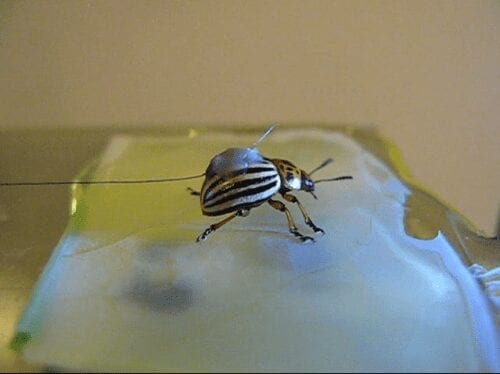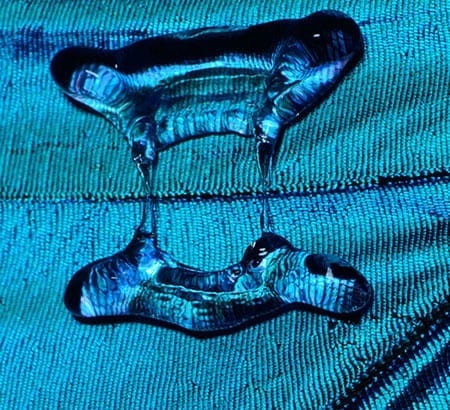
Freiburg research team develops artificial surfaces insects cannot stick to
Beetles, cockroaches, and ants will have a harder time walking on facades or air conditioners in the future – thanks to the bio-inspired, anti-adhesive surfaces Prof. Dr. Thomas Speck, Dr. Bettina Prüm, and Dr. Holger Bohn are developing together with the Plant Biomechanics Group of the University of Freiburg. The team studied plant surfaces in order to determine what influence cell form and microstructure as well as surface chemistry exert on the adhesion behavior of insects.
The researchers conducted adhesion experiments in which Colorado potato beetles walked across differently structured plant surfaces as well as replicas made of synthetic resins. The team used a highly sensitive sensor to measure the traction forces of the beetles on various surfaces. They discovered that wavy or strongly curved cells can increase the adhesive powers of beetles, whereas microstructures composed of wax crystals or cuticular folds reduce them. The latter are tiny folds in the cuticle, a protective layer on the surface of the leaf resembling polyester. The beetles had the hardest time walking on surfaces with cuticular folds with a height and width of approximately 0.5 micrometers and a spacing of between 0.5 and 1.5 micrometers. “That is the perfect anti-adhesion surface. The insects slip off of it much easier than off glass,” says project director Thomas Speck. The cuticular folds reduce the contact area between the adhesive hairs on the beetles’ legs and the plant surface. Unlike on more coarsely structured surfaces, the beetle can’t dig its feet firmly into the cuticular folds. Thus, the microstructure of the surface has a stronger effect on the adhesion of the beetle than the cell form.
The team also took contact angle measurements to investigate the wettability of the various surfaces. The researchers used hydrophobic and hydrophilic artificial moldings of the microstructured plant surfaces in order to study the influence of the surface chemistry on surface wettability and the beetles’ walking behavior. Much like wax crystals, cuticular folds are very good at repelling water. In contrast to the wettability, which depends on both the microstructure and the surface chemistry, the walking behavior of the beetles is not influenced by the surface chemistry. This means that the beetle’s adhesive power depends solely on the physical microstructure of the surface.
Speck and his team published their findings in the current issue of the journal Acta Biomaterialia. In the future, the anti-adhesion surfaces could be used to line the ventilation pipes of air conditioners, which are often teeming with cockroaches and other insects. In addition, they could also be applied to facades and window frames to prevent insects that move predominantly by walking from entering the house and invading the cupboard and medicine cabinet. “This aspect is particularly important in the tropics,” says Speck.
The Latest Bing News on:
Anti-adhesion surfaces
- Yee Hop Holdings' (1662.HK) Subsidiary APEL Triumphs with Three Medals at the International Exhibition of Inventions Genevaon May 5, 2024 at 8:42 pm
This technology was first integrated into household robot vacuum and multipurpose handheld devices in medical field, including surfaces and items disinfection ... through its "contact-killing" and ...
- Anti-Adhesion Products Market Projected to Reach $1.69 billion by 2030 - Exclusive Report by 360iResearchon April 25, 2024 at 8:03 pm
PUNE, India, April 25, 2024 /PRNewswire/ -- The report titled "Anti-Adhesion Products Market by Product Type (Natural Adhesion Barriers, Synthetic Adhesion Barriers), Product Form (Film ...
- ProvaDent Reviews – Proven Oral Probiotic Formula or Hidden Side Effects Risk?on April 18, 2024 at 5:01 pm
However, their role in oral health is equally commendable. Cranberry extract, rich in antioxidants and anti-adhesion properties, can help prevent bacteria from clinging to teeth and gums.
- Subtypes of Lubricant Excipientson April 17, 2024 at 5:00 pm
flow-assisting and anti-adhesion effect. Some drugs may exhibit electrostatic adsorption during the pressing process. The lubricant film has an insulating effect that can stop the buildup of ...
The Latest Google Headlines on:
Anti-adhesion surfaces
[google_news title=”” keyword=”Anti-adhesion surfaces” num_posts=”10″ blurb_length=”0″ show_thumb=”left”]
The Latest Bing News on:
Hydrophobic materials
- Is Water Wet? The Answer is Surprisingly Elusiveon April 25, 2024 at 5:00 pm
deepblue4you/E+/Getty Images The same goes for water-resistant or “hydrophobic” materials such as Gore-Tex, which has a low adhesive force that causes water molecules to coalesce on the ...
- Reducing embodied carbon in concrete constructionon April 25, 2024 at 12:15 am
Mixing water-repelling pore blockers with concrete helps minimize a project’s carbon footprint while maximizing the lifetime of new construction.
- Mixing water and oil: no surfactants neededon April 23, 2024 at 5:00 pm
“Both phases could be made (and controlled to be) homogenous throughout the entire mixture, which could allow us to produce a unique bi-continuous, coexisting hydrophilic and hydrophobic material,” he ...
- Physicists explain, and eliminate, unknown force dragging against water droplets on superhydrophobic surfaceson April 16, 2024 at 7:37 am
But in a counterintuitive twist, the very mechanism that enables hydrophobic surfaces to deflect water droplets also leads to the shearing effect outlined in Backholm's paper. "The field has been ...
- Scientists take a swing at baseball uniforms’ sweat stain issueon April 11, 2024 at 5:00 pm
The chemical route consists of coatings that combine hydrophilic and hydrophobic materials to draw sweat away from the skin. Hinestroza says that, from what he sees in the pictures, the MLB ...
- The Best Way to Remove Gum From Carpeton April 10, 2024 at 5:00 pm
To break it up, dissolve it using another hydrophobic material, like WD-40. (The WD-40 technique should be a quicker fix than the ice technique, because you won’t have to wait around for the gum ...
- Yifei Jinon July 31, 2023 at 6:03 pm
His primary research interests mainly involve 3D bioprinting of living tissue constructs, 3D printing of hydrophobic functional materials, yield-stress fluids for 3D printing applications, ...
The Latest Google Headlines on:
Hydrophobic materials
[google_news title=”” keyword=”hydrophobic materials” num_posts=”10″ blurb_length=”0″ show_thumb=”left”]










